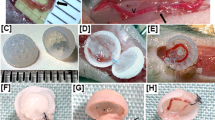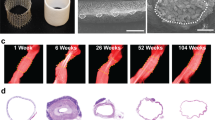Summary
Growing three-dimensional tissue within a chamber requires vigorous angiogenesis initiated by, for example, an arteriovenous fistula or a ligated vascular pedicle. Growth may also be enhanced by contact with the external environment. In this study tissue growth in a rat model, vascularized via an arteriovenous loop (AV Loop) or ligated pedicle, was compared in chambers that were either closed or perforated. Chambers were harvested at 4 weeks and tissue volume and histology compared. In perforated chambers, more tissue were generated using the ligated pedicle (0.75 ml±0.04) than the AV Loop (0.59 ml±0.01). Perforated chambers generated larger volumes of tissue than closed chambers because they encouraged tissue ingrowth through the perforations. Both vessel configurations supported tissue growth but, interestingly, the ligated pedicle resulted in significantly more tissue in the perforated chambers.
Zusammenfassung
Die Generierung dreidimensionaler Gewebekomplexe innerhalb einer Wachstumskammer setzt eine intensive Angiogenese voraus, die beispielsweise durch arteriovenöse Shunts oder einen ligierten Gefäßstiel induziert werden kann. Der Wachstumsprozess lässt sich weiter durch Kontakt mit dem umgebendem Gewebe stimulieren. In dieser Studie wurde das angiofibrinöse Gewebewachstum von arteriovenösen Shunts (AV-Shunts) und ligierten Gefäßstielen in perforierten sowie geschlossenen Kammern im Rattenmodell verglichen. Die Kammern wurden nach vier Wochen entfernt, das Volumen des Gewebes bestimmt und histomorphometrisch analysiert. In perforierten Kammern wurde mit ligierten Gefäßstielen (0,75 ml±0,04) mehr Gewebe als mit AV-Shunts (0,59 ml±0,01) generiert. Die perforierten Kammern produzierten größere Volumina als der geschlossene Typ, da sie eine zusätzliche Angiogenese durch die Perforationen erlaubten. Beide Gefäßstielkonfigurationen förderten das Wachstum von Gewebe, jedoch resultierte interessanterweise aus ligierten Gefäßstielen signifikant mehr Gewebe in den perforierten Modellen.
Similar content being viewed by others
Literatur
Patrick CW Jr. Tissue engineering strategies for adipose tissue repair. Anat Rec, 263: 361–366, 2001
Shenaq SM, Yuksel E. New research in breast reconstruction: adipose tissue engineering. Clin Plast Surg, 29: 111–125, vi, 2002
Jurkiewicz MJ, Nahai F. The use of free revascularized grafts in the amelioration of hemifacial atrophy. Plast Reconstr Surg, 76: 44–55, 1985
Holms RE. Alloplastic Implants. In: IJGM (ed). Plastic Surgery. Philadelphia: Saunders, 1990
Langer R, Vacanti JP. Tissue engineering. Science, 260(5110): 920–926, 1993
Vacanti CA, Upton J. Tissue-engineered morphogenesis of cartilage and bone by means of cell transplantation using synthetic biodegradable polymer matrices. Clin Plast Surg, 21: 445–462, 1994
O'Brien MF, Goldstein S, Walsh S, Black KS, Elkins R, Clarke D. The SynerGraft valve: a new acellular (nonglutaraldehyde-fixed) tissue heart valve for autologous recellularization first experimental studies before clinical implantation. Semin Thorac Cardiovasc Surg, 11(4 Suppl 1): 194–200, 1999
Colton CK. Implantable biohybrid artificial organs. Cell Transplant, 4: 415–436, 1995
Eiselt P, Kim BS, Chacko B, Isenberg B, Peters MC, Greene KG, et al. Development of technologies aiding large-tissue engineering. Biotechnol Prog, 14: 134–140, 1998
Awwad HK, el Naggar M, Mocktar N, Barsoum M. Intercapillary distance measurement as an indicator of hypoxia in carcinoma of the cervix uteri. Int J Radiat Oncol Biol Phys, 12: 1329–1333, 1986
Yang MB, Vacanti JP, Ingber DE. Hollow fibers for hepatocyte encapsulation and transplantation: studies of survival and function in rats. Cell Transplant, 3: 373–385, 1994
Erol OO, Sira M. New capillary bed formation with a surgically constructed arteriovenous fistula. Plast Reconstr Surg, 66: 109–115, 1980
Hirase Y, Valauri FA, Buncke HJ. Creation of neovascularised free flaps using vein grafts as pedicles: a preliminary report on experimental models. Br J Plast Surg, 42: 216–222, 1989
Takato T, Zuker RM, Turley CB. Prefabrication of skin flaps using vein grafts: an experimental study in rabbits. Br J Plast Surg, 44: 593–598, 1991
Wilson YT, Kumta S, Hickey MJ, Hurley JV, Morrison WA. Use of free interpositional vein grafts as pedicles for prefabrication of skin flaps. Microsurgery, 15: 717–721, 1994
Mian R, Morrison WA, Hurley JV, Penington AJ, Romeo R, Tanaka Y, et al. Formation of new tissue from an arteriovenous loop in the absence of added extracellular matrix. Tissue Eng, 6: 595–603, 2000
Mian RA, Knight KR, Penington AJ, Hurley JV, Messina A, Romeo R, et al. Stimulating effect of an arteriovenous shunt on the in vivo growth of isografted fibroblasts: a preliminary report. Tissue Eng, 7: 73–80, 2001
Tanaka Y, Sung KC, Tsutsumi A, Ohba S, Ueda K, Morrison WA. Tissue engineering skin flaps: which vascular carrier, arteriovenous shunt loop or arteriovenous bundle, has more potential for angiogenesis and tissue generation? Plast Reconstr Surg, 112: 1636–1644, 2003
Tanaka Y, Tsutsumi A, Crowe DM, Tajima S, Morrison WA. Generation of an autologous tissue (matrix) flap by combining an arteriovenous shunt loop with artificial skin in rats: preliminary report. Br J Plast Surg, 53: 51–57, 2000
Howard CV, Reed MG. Three-dimensional measurement in microscopy. Unbiased Stereology. Oxford: Bios Scientific Publisher, 1988
Elias H, Hyde DM. Stereological measurements of isotropic structures. In: A guide to practical stereology. Basel: Karger, pp 25–44, 1983
Suzuki S, Matsuda K, Maruguchi T, Nishimura Y, Ikada Y. Further applications of "bilayer artificial skin". Br J Plast Surg, 48: 222–229, 1995
Hofer SO, Knight KM, Cooper-White JJ, O'Connor AJ, Perera JM, Romeo-Meeuw R, et al. Increasing the volume of vascularized tissue formation in engineered constructs: an experimental study in rats. Plast Reconstr Surg, 111: 1186–1192, discussion 93–94, 2003
Cassell OC, Morrison WA, Messina A, Penington AJ, Thompson EW, Stevens GW, et al. The influence of extracellular matrix on the generation of vascularized, engineered, transplantable tissue. Ann NY Acad Sci, 944: 429–442, 2001
Bayati S, Russell RC, Roth AC. Stimulation of angiogenesis to improve the viability of prefabricated flaps. Plast Reconstr Surg, 101: 1290–1295, 1998
Bouhadir KH, Mooney DJ. Promoting angiogenesis in engineered tissues. J Drug Targeting, 9: 397–406, 2001
Hofer SO, Mitchell GM, Penington AJ, Morrison WA, Romeo Meeuw R, Keramidaris E, et al. The use of pimonidazole to characterise hypoxia in the internal environment of an in vivo tissue engineering chamber. Br J Plast Surg, 58: 1104–1114, 2005
Tanaka Y, Sung KC, Fumimoto M, Tsutsumi A, Kondo S, Hinohara Y, et al. Prefabricated engineered skin flap using an arteriovenous vascular bundle as a vascular carrier in rabbits. Plast Reconstr Surg, 117: 1860–1875, 2006
Lokmic Z, Stillaert F, Morrison WA, Thompson EW, Mitchell GM. An arteriovenous loop in a protected space generates a permanent, highly vascular, tissue-engineered construct. Faseb J, 21: 511–522, 2007
Author information
Authors and Affiliations
Corresponding author
Rights and permissions
About this article
Cite this article
Dolderer, J., Kehrer, A., Schiller, S. et al. De-novo Generierung von vaskularisiertem Gewebe mittels unterschiedlicher Gefässstielkonfigurationen in perforierten und geschlossenen Wachstumskammern. Wien Med Wochenschr 160, 139–146 (2010). https://doi.org/10.1007/s10354-009-0734-0
Received:
Accepted:
Issue Date:
DOI: https://doi.org/10.1007/s10354-009-0734-0
Keywords
- Tissue engineering
- Angiogenesis
- Autologous soft tissue replacement
- Reconstructive surgery
- Growth chambers




